
Caucasian Albania is a modern exonym for a former state located in ancient times in the Caucasus: mostly in what is now Azerbaijan. The modern endonyms for the area are Aghwank and Aluank, among the Udi people, who regard themselves as descended from the inhabitants of Caucasian Albania. However, its original endonym is unknown.
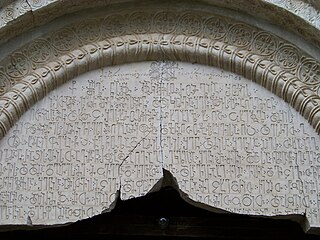
The Georgian scripts are the three writing systems used to write the Georgian language: Asomtavruli, Nuskhuri and Mkhedruli. Although the systems differ in appearance, their letters share the same names and alphabetical order and are written horizontally from left to right. Of the three scripts, Mkhedruli, once the civilian royal script of the Kingdom of Georgia and mostly used for the royal charters, is now the standard script for modern Georgian and its related Kartvelian languages, whereas Asomtavruli and Nuskhuri are used only by the Georgian Orthodox Church, in ceremonial religious texts and iconography.

Saint Catherine's Monastery, officially the Sacred Autonomous Royal Monastery of Saint Katherine of the Holy and God-Trodden Mount Sinai, is an Eastern Orthodox Christian monastery located at the foot of Mount Sinai, in the Sinai Peninsula, Egypt. Built between 548 and 565, it is the oldest continuously inhabited Christian monastery in the world.
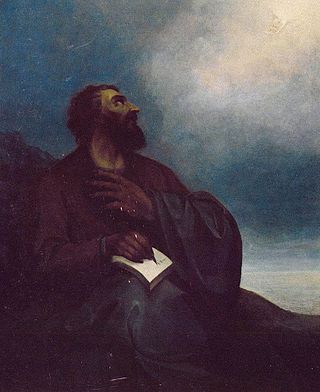
Mesrop Mashtots was an early Medieval Armenian linguist, composer, theologian, statesman, and hymnologist in the Sasanian Empire. He is venerated as a saint in the Armenian Apostolic Church, the Armenian Catholic Church, the Eastern Orthodox and Roman Catholic churches. He is best known for inventing the Armenian alphabet c. 405 AD, which was a fundamental step in strengthening Armenian national identity. He is also considered to be the creator of the Caucasian Albanian and Georgian alphabets by a number of scholars.

The Matenadaran, officially the Mesrop Mashtots Institute of Ancient Manuscripts, is a museum, repository of manuscripts, and a research institute in Yerevan, Armenia. It is the world's largest repository of Armenian manuscripts.

Udis are a native people of the Caucasus that currently live mainly in Russia and Azerbaijan, with smaller populations in Georgia, Armenia, Kazakhstan, Ukraine and other countries. Their total number is about 10,000 people. They speak the Udi language, which belongs to the Northeast Caucasian language family. Some also speak Azerbaijani, Russian, Georgian or Armenian, depending on where they reside. Their religion is Christianity.
Movses Kaghankatvatsi, or Movses Daskhurantsi is the reputed author of a tenth-century Classical Armenian historiographical work on Caucasian Albania and eastern provinces of Armenia, known as The History of the Country of Albania.
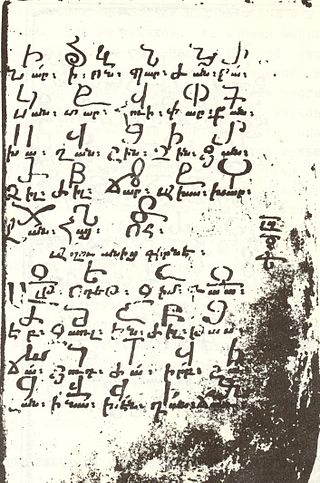
The Caucasian Albanian script was an alphabetic writing system used by the Caucasian Albanians, one of the ancient Northeast Caucasian peoples whose territory comprised parts of the present-day Republic of Azerbaijan and Dagestan.
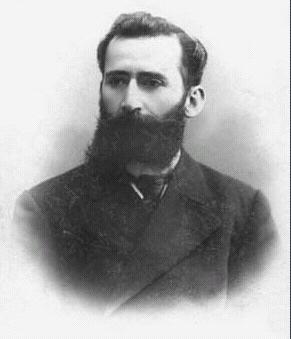
Ilia Abuladze was a distinguished Georgian historian, philologist and public figure, a Corresponding Member of the Georgian Academy of Sciences (GAS) (1950), Meritorious Science Worker of Georgia (1961), Doctor of Philological Sciences (1938), and professor (1947).
Sanesan or Sanatruk was the king of Maskut in the early 4th century. Sanesan's people, the Mazk'kut'k, have variously been identified as the Massagetae or as the Meskheti.
The Church of Albania or the Albanian Apostolic Church was an ancient, briefly autocephalous church established in the 5th century. In 705, It fell under the religious jurisdiction of the Armenian Apostolic Church as the Catholicosate of Aghvank centered in Caucasian Albania, a region spanning present-day northern Azerbaijan and southern Dagestan.

The Armenian alphabet is an alphabetic writing system used to write Armenian. It was developed around 405 AD by Mesrop Mashtots, an Armenian linguist and ecclesiastical leader. There are several inscriptions in Armenian lettering from Sinai and Nazareth, dating to the beginning of the 5th century, found by Michael Stone. The system originally had 36 letters; eventually, two more were adopted. The alphabet was also in wide use in the Ottoman Empire around the 18th and 19th centuries.
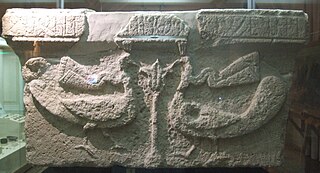
Caucasian Albanian is an extinct member of the Northeast Caucasian languages. It was spoken in Caucasian Albania, which stretched from current day south Dagestan to Azerbaijan. Linguists believe it is an early linguistic predecessor to the endangered North Caucasian Udi language. The distinct Caucasian Albanian alphabet used 52 letters.
The History of the Caucasian Albanians by Movses Kaghankatvatsi is a history of eastern territories of Armenia, as well as other territories in Southeastern Caucasus usually described as Caucasian Albania. The work was written in Old Armenian. It covers the period between 4th century AD and 10th century AD.
Grigoris was the Catholicos of the Church of Caucasian Albania ca. 325–330 AD. He is considered a saint martyr by the Armenian Apostolic Church.

Saint Elisæus, Ełišay, Yeghishe or Ełišē was the first patriarch of the Church of Caucasian Albania by local tradition.

Jost Gippert is a German linguist, Caucasiologist, author, and professor for Comparative Linguistics at the Institute of Empirical Linguistics at the Goethe University of Frankfurt.
Zaza Aleksidze was a Georgian historian and linguist who specialized in Armenian and Oriental studies. He is best known internationally for deciphering the Caucasian Albanian script.
Eghiazar was the Catholicos and head of Caucasian Albanian Church in the late 7th century.
Nerses Bakur was the Catholicos and head of Caucasian Albanian Church in the late 7th and early 8th century.











